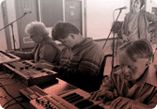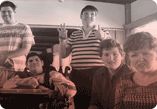   |
Tra La La Blip: Ableton Live inspires disabled musiciansRandolf Reimann is a musician, a support worker for people with intellectual and physical disabilities, and the founder of Tra La La Blip, which was created in 2008 to provide a fertile environment in which intellectually and physically handicapped people would have access to new technologies that would enable more creative possibilities for self-expression. The vision also included the goal of creating a CD that the participants could take home. Inside a small community hall, tucked away in rural Australia, the first jam took place. It was clear then that this setup of MIDI equipment and a laptop running Ableton Live 7 allowed for pure and uninhibited blossoming of original creativity. For many of the participants, it was the first time they had heard their own voices or their own compositions played back to them, and it did not take long for them to realize that this was not karaoke--they were singing and accompanying their own songs. The first compilation CD, Soundbeam Sessions Vol 1, is now complete, and the song "icecream truck" by MSG is getting airplay nationally in Australia on Triple J FM. We recently had the chance to talk with Reimann about how he and the artists of Tra La La Blip use Ableton Live. When did you first get into Live? I've been using Live since version 1.5. I sold my Yamaha SU700 and got a PowerBook running Live 1.5. That was back in 2001 or 2002. I was vocalist for the Sydney hardcore punk band Massappeal and programmer for Byron Bay electronica/folk band Kolliope, and I used Live in both projects. How do you use Live in Tra La La Blip? Live 7 is at the heart of the Tra La La Blip setup. In fact, I doubt that this project would be possible without it. I have multiple MIDI controllers (five or six) and a mic all hooked up to a MacBook running Live. The MIDI scale effect is very important, and the ability to make loops immediately on multiple channels allows me to give the musicians instant feedback on their creativity. A session goes for an hour, and in that time we (the bands and me) start by jamming together, listening and choosing loops that we like, discussing lyrical ideas and then recording the vocals. Sometimes an individual may come to the jam with a pre-conceived lyric idea, but most of the vocals are very spontaneous. On occasion we have had one participant holding up their artwork while the vocalist sings about the painting or drawing. And now, some of the musicians are starting to use Live directly to do programming. Do you use VSTs or live instruments? We use all the Ableton Suite instruments, and I love being able to tweak individual drum tracks in Live 7. We also use the Yamaha Tenori-On and the Korg Kaossilator. Is there anything else you'd like to see in Live? Yes, in working with people with disabilities, I see that the ability to resize the GUI and maybe simplify what is on the screen would be very beneficial. It would make learning and understanding this great instrument/DAW a possibility to a spectrum of the population that usually do not get to experience such a wonderfully creative tool. How does Live help you creatively? Live is my main musical instrument! That question is sort of like asking a painter how a paint brush helps them creatively. To enjoy the music of Tra La La Blip, or to contact Randolf for more information, visit: www.myspace.com/tralalablip or email tralalablip@live.com |